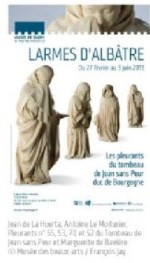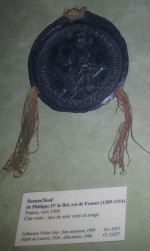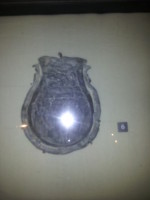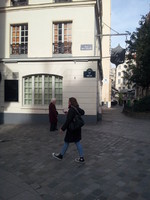Travel Log Monday 18th March 2013
After an easy morning without rushing ourselves, Tom joined me in my usual habit of wandering round until finding the right place. We were looking for the Museum of the Middle Ages which is housed in the former Hôtel de Cluny. Having explored the university quarter around the Sorbonne (not that we had intended to) we finally consulted Tom’s downloaded google map, and turned right where earlier we had gone astray by going straight.
The building which used to be the Parisian residence of the Cluniac abbots is impressive and it is full of old treasures. Here we encountered more of the fall-out from the Revolution, with all manner of decapitated statues. Many are from Notre Dame de Paris, including a set of heads discovered in 1977, which once adorned the Western façade; the revolutionary outrage had been vented on what are understood to have been depictions of the royal Capetians, in the guise of biblical Judean Kings. There is still some evidence of the colourful paint originally adorning the heads when they were sculpted in the 1220s. We also saw some of the rich religious paraphernalia that belonged to churches and abbeys from across the country, some of which could have been seen by Marguerite in her lifetime.
On entering the museum the first exhibit was a series of stone sculptures on loan from Dijon, and which have been on tour. “Tears of Alabaster” (Larmes d’Albâtre) would indeed be a great name for a band. These 37 mourners are from the tomb of Jean sans Peur (John the Fearless); he was a Duke of Burgundy and Capetian prince who was assassinated in 1419. This era was way after my personal historical interest and more to do with the 100 years war, but the miniature stone figures were striking in their “dramatic intensity” and their “delicacy” (as the write up on the website promised). The spectre of grief is ever with us, and untimely death hard for any family to bear. I wonder what memorials of grief the poor were able to adopt for themselves, having no recourse to craftsmen and marble to express their agony. Did such public monuments to dead nobles act as a focus for the private griefs of many, somewhat like the outpouring of grief at the funeral of Princess Diana in 1997? I wondered who mourned for Marguerite in 1310. Did her family? Her friends? Her “followers” if she had any? There was no body for them to bury. Heretics were burnt to ash deliberately so that there would be no relics to be retrieved for veneration. Not that I think Marguerite countenanced such worship of a human being. Her relationship with God was rather about personal connection with the divine, not through a mediator of any kind.
Moving on from such bleak thoughts, let us illuminate the darkness with what is, in my opinion, the pièce de resistance of this museum. In a dimly lit, circular room there are the most breath-taking tapestries I have ever seen. The gigantic wall-hangings telling the story of “La Dame à la licorne” (The Lady and the Unicorn) are also from a much later time than I was interested in, but I have to admit that this was a sight worth the visit all on its own. The vibrant reds, greens, blues and yellows of the images made up from the tiniest of stitches are a feast for the eyes. The six tableaux pose a question for the onlooker to ponder: Five of them each depict one of the senses, and the larger sixth tapestry shows the lady in front of a tent entitled “A mon seul désir” which is slightly ambiguous; amongst other things it could be translated as “To my one desire” or “according to my desire alone”.
No flash photos were allowed, so my snaps are not bright enough to display here – click here for a link to the Wikipaedia page. The images evoke the whole idea of courtly love, a vehicle used by Marguerite some two centuries earlier to convey her understanding of desire and its hold on the soul. Is the taking off and putting away of the necklace shown in the larger tapestry a relinquishment of material values? An acknowledgment that the lady’s sole desire is to be denuded of all worldly things? I am of course reading the series of images through the Mirror of Marguerite Porete. There are many possible - and offered - interpretations.
We decided on the way back to the flat to buy lots of delicious treats for tea instead of going out to dine. Fresh baguette, cheeses, meats, salad and wine. Lovely. Tom had been doing some research on cocktail bars to try , so we chose one and made our way there by metro since it had been raining on and off all day. That was marginally better than the recent snow I’d had to deal with. I have to say I was disappointed with the margarita I’d ordered and Tom did not appreciate the ambience of the place so we decided to stroll around and find somewhere else.
Down a cobbled alley we found Le Pub St Germain. This was probably our best find of the week. Great surroundings, good service and excellent cocktails. I pushed the boat out and tried an offering from the ‘poets’ menu that had absinthe as an ingredient. It was delicately flavoured and Tom’s Negroni was pleasing to his palate. I am not only receiving an education on medieval Paris, but also on the more up-to-date trends of downtown St Germain des Pres. With my lighter head we made our way home, wondering what sort of “private club” it was that was situated on the corner of our street… must google it.














